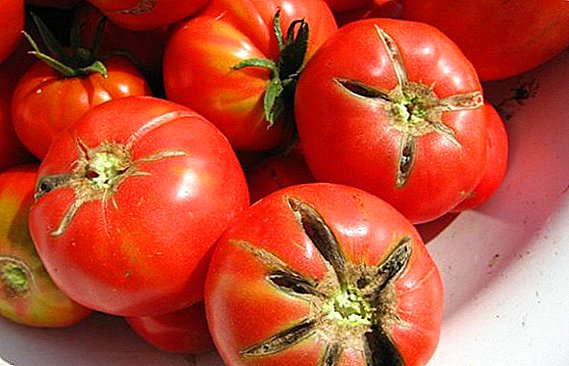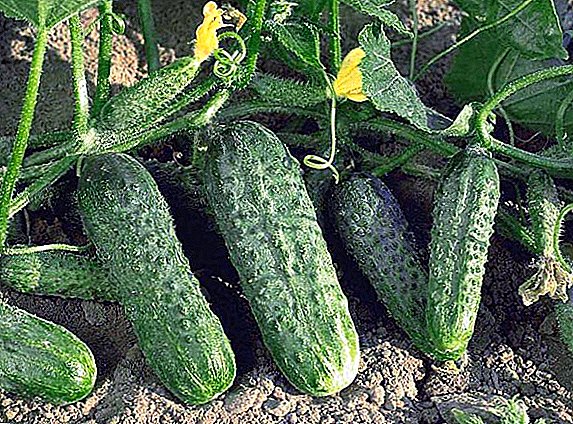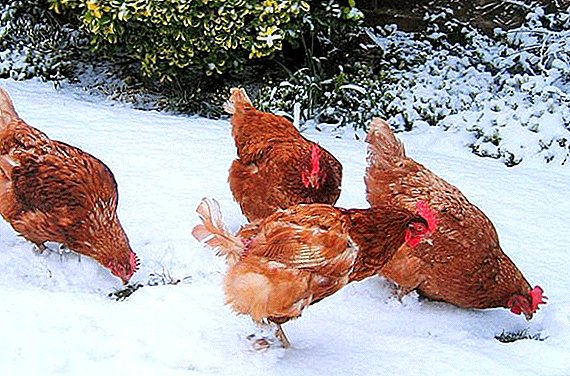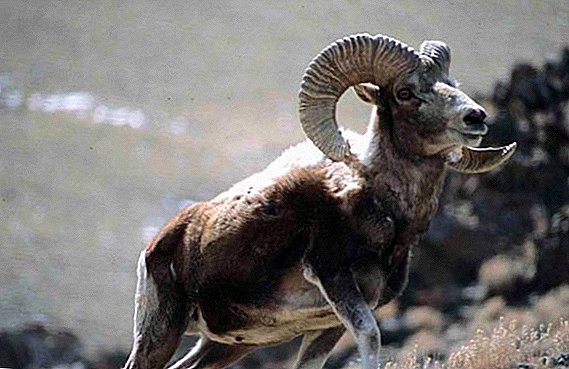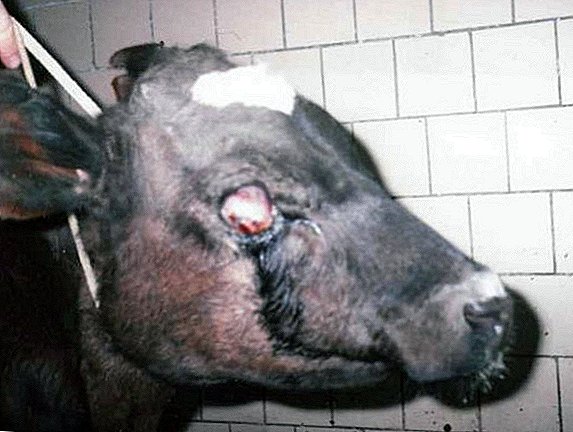 Breeding cattle in rural areas is a common and profitable occupation. But the farmer’s everyday life can be overshadowed by the serious and contagious illness of the wards - for example, malignant catarrhal fever.
Breeding cattle in rural areas is a common and profitable occupation. But the farmer’s everyday life can be overshadowed by the serious and contagious illness of the wards - for example, malignant catarrhal fever.
Learn more about this disease, its symptoms and course of treatment of animals.
What is this disease
Malignant catarrhal fever (hereinafter referred to as CGD) is an infection that occurs within one group of animals and does not lead to outbreaks of epidemics. The disease affects the central nervous system, digestive, respiratory system through inflammation of the mucous membranes. The percentage of mortality from ZKG is quite high, so it is important to diagnose it in time and begin treatment.
Anaplasmosis, parainfluende-3, actinomycosis are also referred to as infectious diseases of cattle.
Pathogen, sources and routes of infection
The causative agent of the disease is a virus belonging to the family of herpes. The virus may be found in the lymph and mucous membranes of the brain, liver, spleen, pancreas. Carriers are goats and sheep; under appropriate conditions, it is excreted with saliva or mucus from the sinuses. It has been proven that infection does not occur upon contact between sick and healthy individuals, but with the slightest symptoms of suspicious animals they are isolated, since the exact mechanism of the spread of the virus has not been studied.  The carriers of the virus are goats and sheep. The following factors may contribute to the creation of an environment suitable for the virus:
The carriers of the virus are goats and sheep. The following factors may contribute to the creation of an environment suitable for the virus:
- off-season;
- substandard feed;
- dietary errors;
- joint keeping and grazing of different groups of animals (cows and sheep, horses and goats);
- excessive moisture in the place of detention;
- drafts and low temperature.
Important! The virus can infect an embryo of a pregnant female, as its particles penetrate the placenta.
Incubation period and symptoms
The latent period can last from 12 hours to four months, so it is important to observe the behavior of animals. The diseased immediately fails in the nervous system:
- earlier, good-natured individuals become excitable and aggressive;
- previously active specimens fall into apathy, oppression.
 The disease covers almost the entire body. A variety of organs suffer from it, which causes the corresponding symptoms:
The disease covers almost the entire body. A variety of organs suffer from it, which causes the corresponding symptoms:
- the immune system - chills, fever, fever;
- CNS and heart - hyperexcitability, lowing, gnashing of teeth, muscle tremors, convulsions, pulse, filiform and frequent;
- GIT - loss of appetite, thirst, constipation, atony of the anterior stomach, diarrhea (maybe with blood), gastroenteritis, abdominal muscle spasms;
- leather - the areas between the horns and the frontal part become hot, the skin hardens, the fur becomes on end;
- musculoskeletal system - wobbly, bending of the limbs, arching the back;
- eyes - intolerance of light, swelling of the eyelids, lacrimation, conjunctivitis in severe form, corneal clouding, ulceration of the mucous membrane, loss of the iris or its accretion with the lens, cataract, blindness;
- respiratory system - shortness of breath, choking, wheezing when breathing, swelling of the larynx and nostrils, abundant salivation and secretion of mucus from the sinuses;
- urinary system - necrosis and ulcers of the vaginal mucosa, swelling of the labia, frequent urination, cystitis, nephritis, miscarriage.

Important! During this period, the animal cannot be tied by the horns - they soften greatly and may fall off.
According to the severity of symptoms distinguish acute, subacute and hyperacute forms of the disease:
- in the subacute form, the symptoms are mild: only behavioral changes are observed, fever, dryness in the nasal mirror, secretion of mucus from the nasal sinuses and swelling of the eyelids are possible.
- in the acute course, the signs are pronounced, the animal loses coordination of movements, the milk of the females disappears, the body temperature rises sharply to 42 ° C. In nine cases out of ten within two weeks, with acute form and no treatment, death occurs.
- in an over-acute form, symptoms of central nervous system damage are complemented by loss of appetite, thirst, shortness of breath, and the stool becomes liquid and bloody. Death can occur on the third day.

Diagnostics
The diagnosis can only be established by a specialist, since many of the symptoms are similar to other diseases. For an accurate picture, analyzes are needed:
- histological;
- PCR diagnostics (DNA and RNA studies);
- analysis of scrapings of affected tissues;
- blood test and lymphatic fluid.
Did you know? A cow is often crossed with other representatives of large cloven-hoofed animals. - for example, with yak. The resulting hybrid, Hainak, is characterized by an increased number of yields.
Pathological changes
Pathological studies help to study the mechanisms that trigger the virus.  Dissecting the body of a fallen animal, experts observe these changes:
Dissecting the body of a fallen animal, experts observe these changes:
- exhaustion;
- blood clotting, darkening;
- necrosis of the mucous membranes of the respiratory and digestive organs;
- necrosis and ulcers on the skin, udder, nipples;
- hemorrhages on the mucous and serous covers of the liver, spleen, prostate and pancreas, brain, adrenal glands;
- enlarged lymph nodes in the abdominal cavity, submandibular and pharyngeal nodes;
- blood stasis in the liver, myocardium, kidney, brain;
- edema in the lungs;
- the membranes of the brain are also swollen and covered with dried liquid from the blood vessels;
- hemorrhages in the connective membrane of the eyelids;
- dull cornea.
Read about the main diseases of cows, their symptoms and treatment.
Control and treatment
Patients are immediately placed in an isolator, where a comprehensive treatment is carried out:
- with the development of secondary infections on the background of the virus, antibiotics and sulfonamides (Draxin, Exid, Terramycin) are prescribed, the drug is administered once, injected, in the dosage indicated by the veterinarian;
- caffeine is injected subcutaneously to maintain the central nervous system and heart activity (dosage depends on the weight and severity of the condition);
- for disorders of the gastrointestinal tract, anti-inflammatory and astringent drugs are used - for example, Tannin, which heals mucous membrane ulcers, and also watered the animal with oats, flaxseed or rice broth;
- for severe edema, 10% calcium chloride is injected, the dosage and frequency are calculated by the veterinarian;
- external mucous membranes are washed with a weakly pink solution of potassium permanganate or with chamomile decoction, succession;
- for the treatment of eyes, a 5% solution of dimexide in a mixture with 0.5% novocaine with the addition of gentamicin is used, it is dripped onto the inner surface of the eyelid;
- Streptocidal or oxytetracycline ointment is used to treat ulcers on the skin.


We advise you to familiarize yourself with the rules of feeding dairy cows.
Prevention
Since it has been established that sheep and goats are virus carriers, it is not necessary to keep together with them or to graze on one territory other animals. In addition, measures are being taken to prevent the disease:
- Regularly conduct a routine inspection of the population.
- Observe sanitary standards: maintain the cleanliness of the barn or stables, cleanliness of equipment, personal hygiene when milking animals or caring for them. The litter and excrement of animals are removed as they are polluted, and they are taken away from the habitat of pets.
- Also observe the sanitary safety of grazing and watering.
- As food give exclusively fresh and high-quality food. The diet of animals should be optimally balanced with vitamins and minerals, especially in spring and autumn, when the HCV virus is active.
- New animals temporarily placed in quarantine.
- Indoors keeping cattle exclude drafts, dampness, the appearance of rodents.
- Sanitary disinfection of cowsheds or stables is carried out regularly, treating both the premises and the equipment, for example, with 2% caustic soda.
- When suspicious symptoms appear, the animal is isolated from healthy individuals. The rest of the wards carefully inspect.
- The poor farm is quarantined, dead animals are disposed of. Quarantine is removed only if the veterinarian confirms complete healing of the livestock.

Did you know? Buffalo's milk is much fatter cow's, make it a delicious Italian mozzarella.
Owners of livestock farms, armed with practical knowledge about the possible diseases of their wards, will be able to take the necessary measures to prevent them. If the disease still manifests itself, timely assistance will save livestock from death, and the owner from losses.


